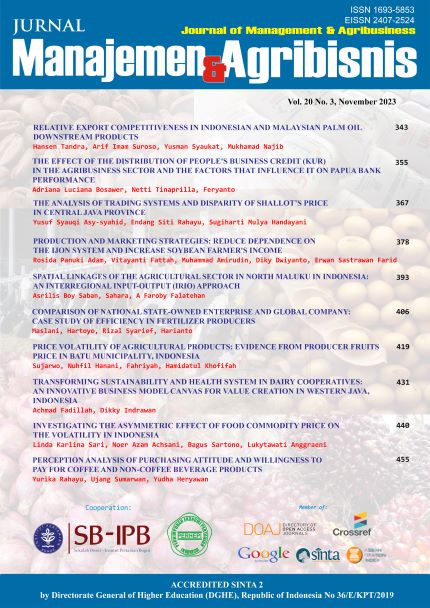Investigating The Asymmetric Effect of Food Commodity Price on The Volatility in Indonesia
Abstract
Volatility can be measured, but in fact, there is still frequent debate over the selection of precise measurements in describing volatility. In Indonesia, the commodity market is known for its volatile prices, which can impact the livelihood of farmers, traders, and the wider economy. The existence of possible asymmetry in the behavior of food commodity price volatility in the Indonesian market is not yet known. This paper aims to determine the best model to describe the volatility and to investigates the presence of the asymmetric effect on the volatility of food prices in Indonesia, over the period 2009-2019, on a monthly basis. Modeling of volatility uses the GARCH family model, both symmetric and asymmetric. The results showed that the GARCH asymmetric model produces better performance than the symmetric GARCH. Through the best GARCH asymmetric model, the food commodities used in this study showed a statistically significant asymmetrical effect on volatility. Nevertheless, policymakers and market players need to be aware of the impact of market volatility and implement measures such as real-time price information systems to mitigate its effects. The government can increase food production by providing support to farmers in managing supply efficiency and improving agricultural infrastructure.
Keywords: agricultural commodity, asymmetric effect, asymmetric GARCH, modeling volatility
Authors
Authors who publish with this journal agree to the following terms:
- Authors retain copyright and grant the journal right of first publication with the work simultaneously licensed under a Creative Commons Attribution License that allows others to share the work with an acknowledgement of the work's authorship and initial publication in this journal.
- Authors are able to enter into separate, additional contractual arrangements for the non-exclusive distribution of the journal's published version of the work (e.g., post it to an institutional repository or publish it in a book), with an acknowledgement of its initial publication in this journal.
- Authors are permitted and encouraged to post their work online (e.g., in institutional repositories or on their website) prior to and during the submission process, as it can lead to productive exchanges, as well as earlier and greater citation of published work (See The Effect of Open Access).

